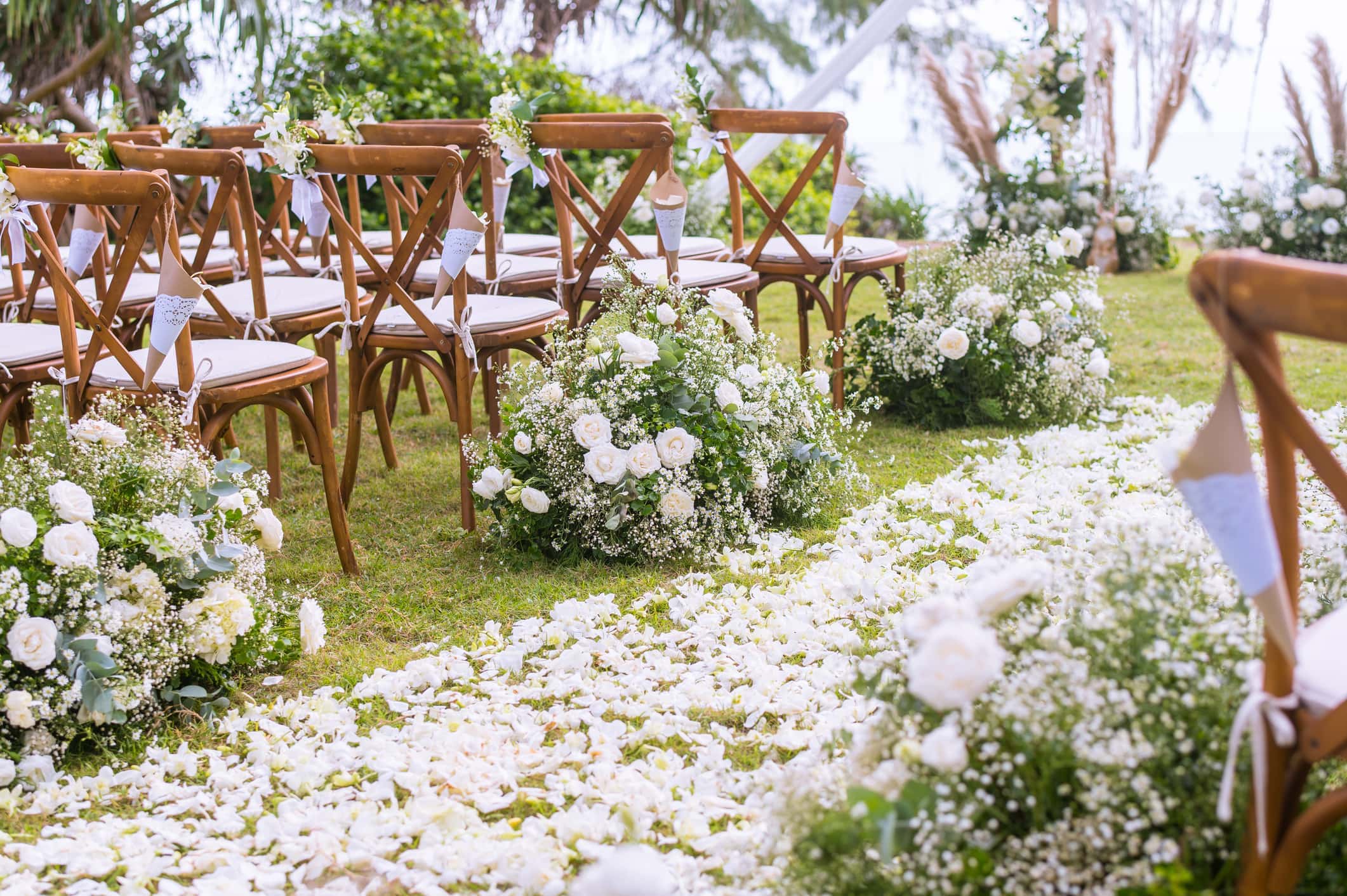As you make your way through your wedding planning checklist, you might be asking yourself how to plan for the actual ceremony and reception itself. And while it’s true that every wedding is unique in its own way, there’s a general flow that every wedding tends to follow. In this guide, you’ll learn the order of events for the ceremony and reception of a traditional, non-denominational wedding.
Traditional wedding ceremony – Order of events
- The procession. The procession begins with the officiant taking his or her place at the altar. Then, the groom will stand to the left (typically) of the altar. The rest of the wedding party will take their positions in a few different ways. The best man could approach first and stand next to the groom. The groomsmen and bridesmaids can arrive together in pairs, with the best man and maid-of-honor arriving last. The exact order is up to the newlyweds’ preference. The flower girl and ringbearer follow up the wedding party. Finally, the bride walks down the aisle, often escorted by her father.
- The officiant’s opening remarks. Once everybody’s in their places and the other guests are seated, the officiant will give some opening remarks about the couple and the joy and beauty of marriage. “We are gathered here today…” is the most well-known opening line in marriage ceremonies, but the officiant (with the guidance of the couple) can begin by saying something different. Depending on the theme of the wedding, opening remarks can be serious, poetic, or light-hearted.
- Exchanging of vows. After the officiant’s opening remarks, he or she will ask the couple to recite their vows to one another.
- Exchanging of rings. The couple place their wedding bands on their partner’s finger. Traditionally, the groom places a ring on the bride’s finger first. In some ceremonies, each future spouse will say a declaration of love before putting a wedding band on their partner’s finger.
- Pronouncement of marriage. With the rings exchanged, it’s time for the pronouncement of marriage. The officiant will officially declare the couple married.
- The kiss. The big moment arrives as the newlyweds share their first kiss as a married couple.
- Closing remarks. The officiant says a few poignant last words as the guests prepare for the recessional.
- The recessional. The newlyweds walk away from the altar first, followed by the rest of the wedding party. Once everybody’s cleared the aisle, the guests can get up and make their way toward the reception area.
Traditional wedding reception – Order of events
- Cocktail hour. Typically immediately after the wedding ceremony, the cocktail hour will start. Guests can munch on hors d’oeuvres, grab a cocktail or two (or three) and mingle amongst themselves and the wedding party. This is also a great opportunity for your wedding photographer to get some good shots!
- Cocktail hour ends. As soon as cocktail hour ends (usually with an announcement), guests will slowly make their way to their assigned tables or seats. Some guests will immediately sit down while others extend cocktail hour for as long as possible.
- Wedding party entrances and Introductions. Once all the guests are seated, it’s time for entrances and introductions. It’s common to have the DJ introduce the wedding party in this order: the newlyweds’ parents, bridesmaids, groomsmen, ring bearer, flower girl/boy, best man(or woman), maid/matron of honor and the newlyweds.
- Dinner. Once the newlyweds take their places at the head of the table, dinner can officially start. And not a moment too soon.
- Toast and speeches. Now that the guests started slowing down and pushing their plates away, the best man and maid of honor will make their toasts. After that, the newlyweds will make their speeches, followed by the parents, and then anyone else who wants to make a speech will get their turn.
- First dance. Hopefully the speeches don’t drag out for too long, because next up is the first dance. An already nervous couple gets to slow dance for several minutes while dozens (or hundreds) of close friends and families look on. Chances are they’ll be too lost in each other’s eyes to notice the gawking crowd.
- More dancing. After the happy couple finishes their song, the night can proceed in a few different ways. If father/daughter and mother/son dances are on the agenda, they’ll go next (in that order). If not, the bridesmaids and groomsmen will join the newlyweds on the floor to kick off the reception dance party.
- Bouquet and garter toss. Time-honored tradition or cringey relic of the past? That’s up for the newlyweds to decide. If they opt for the bouquet and garter toss, it’ll signal the end of the dance segment of the reception. If you’re planning your wedding and want to toss a bouquet, ask your florist to prepare one that’s designed specifically for tossing.
- Cake-cutting. By now, dinner plates have been cleared from tables while everyone is on the dance floor cutting a rug. Cake-cutting and dessert is a universal sign that the reception is starting to wrap up.
- Last song. After dessert, there’s still time for a few more songs on the dance floor. This is everyone’s opportunity to get their final moves in before the last song. The last song will be chosen by the newlyweds and signifies the end of the reception.
- End of reception. Everyone hugs and takes last-minute selfies and says their goodbyes. But just because the reception’s over doesn’t mean the fun has to stop. As the septuagenarians all head back to their homes or hotel rooms, this is typically the time the after-party kicks off.
How to plan your wedding: A 12-month checklist
If you think the ceremony and reception have a lot of steps, wait until you start tallying up all the tasks you need to do leading up to your wedding. If you recently got engaged and you’re not sure where to start, take a look at this wedding planning checklist. It’ll take you from setting a budget one year before you tie the knot all the way until you arrive at the venue on the day of.
And don’t let unexpected events undo all your hard work! Nasty weather and personal emergencies can alter even the most meticulous wedding planning. Consider investing in wedding insurance to protect yourself from situations outside your control.










